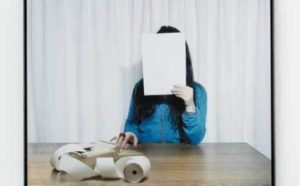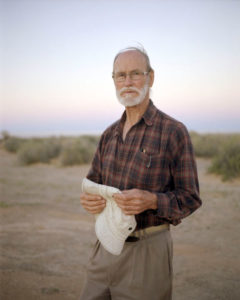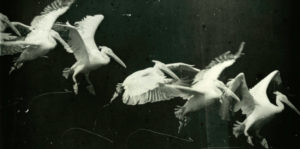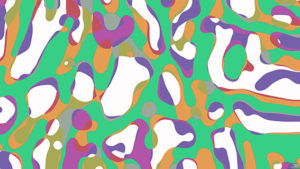The BA Photography Studios for Semester 2, 2020 are described below. These are the options for the first and second year students offered under the following course codes:
Photography Studio 1 VART 3593 (1st year)
Photography Studio 3 VART 3597 (2nd year)
Please read them carefully and decide upon your first, second and third preferences.
Provided you are enrolled in one of these courses, you will be able to nominate your preferences through myTimetable between 22nd of June and the 29th of June, 2020.
IMPORTANT – You must not repeat Studios and you must enter three different preferences. Every effort will be made to place you in your first or second preference. Allocations are made on the basis of space available and group balance, with the higher year level being given priority (i.e it is not 'first come, first served').

Sophie Calle, "Take Care of Yourself", 2007
1. Forms of Encounter and Exchange: Collingwood Studio
Creative practitioners are increasingly collaborating with other artists, communities and institutions in response to the excess of individualism, a desire for social connection, and to activate politics. This ‘social turn’ in art and photography has renewed conversations about the role of creative practice in the community, the ethics of collaboration, the contexts of production, and the benefits of increased civic participation.
This studio is a critical inquiry into the contribution of creative practice to public discourse and the different ways in which forms of encounter and exchange can be undertaken. Students will participate in a 12-week residency in a studio with local partners in the suburb of Collingwood. Here, they will explore forms of collaboration—through a process of co-creation, and a series of individual exercises and group projects with community-led initiatives.
Current and previous partners include The Social Studio, RHYMS (with Drummond Street Services), Collingwood College, Cultivating Community, The Wellington Centre, The Out For Good Project (with the Centre for Innovative Justice), The Big Umbrella (with ABC Fact Check), The Bendigo Hotel, Visual Stories workshop (with the Centre for Multicultural Youth), and the Tote Hotel.
Blended learning may include a series of online seminars, reading and discussion of critical texts, community consultation and engagement, research into site and social contexts, and projects centred around the development of a shared ethical framework for the Collingwood Studio.
Evaluation of the work will privilege practice-led research, ethics, and quality, in relation to the aspirations and values of our partners. Project outcomes are not predetermined, but rely on consultation and engagement with partners. Creative outcomes might include broadsheets, podcasts, community arts workshops, documentary films/essays, books, activist campaigns, public events, public artworks, and exhibitions.
Aims:
- Develop skills in active listening and relational ethics.
- Produce a project in collaboration with community partners.
- Demonstrate an applied critical understanding of the politics of representation and collaborative practices.
Further Information: A high level of commitment and initiative is required in addition to a willingness to work with community partners. The studio will take place in Collingwood as part of RMIT’s The Photo Lab—a project space for students, alumni, staff, and community. Students will have access to an individual workspace for the duration of the semester, a community of artists in residence, and printing facilities.

Avon, Lake Eyre, South Australia, 2014
2. In & Of the World: Approaches to Documentary Photography
The civil must be … defined in its own right as the interest that citizens display in themselves, in others, in their shared forms of coexistence, as well as in the world that they create and nurture - Ariella Azoulay (2012)
How can documentary practice help us understand and engage with the world?
Documentary photography has long played an important role in bearing witness to world events and the interpretation of personal, political and social lives lived globally. Yet the practice of documentary photography has undergone significant reconsideration, reinvention and reimagination with the advent of digital technology and the sheer proliferation of images.
The recent theoretical works of Ariella Azoulay have been influential in understanding photography’s civil functions. In particular, this studio will focus on exploring the practical potential of key concepts in Azoulay’s work, such as the ‘civil contract’ and ‘political ontology’ of photography.
Through the development of a visual project, which links forms of critical inquiry, theoretical underpinnings and technical understandings, students will consider different modes of documentary practice which span storytelling, activism and reportage, as they use the camera to engage with the world around them.
Aims:
- Produce a body of work which explores a contemporary social issue or story.
- Develop an awareness of contemporary photographic theory as it relates to documentary practice.
- Develop technical, conceptual, and aesthetic skills for the production of documentary photography.
- Develop and refine the ability to be self-reflective and to critically evaluate documentary images.

Chronophotograph, Etienne-Jules Marey, 1882
4. Moving Image
“The movies are a revolution.” Taylor Mead
“… cinema, with its celebrated ability to record movement, serialised photographic instants, imbuing them with an invisibility crucial to the maintenance of its illusion. The instant - embodied in the film frame - must disappear in order for movement to emerge.” Mary Ann Doane, Real Time: Instantaneity and the Photographic Imaginary
In this studio our enquiry will be driven by an investigation of what movement and duration can offer in lens-based media. The course is designed to provide an opportunity for students to develop their time-based creative practice, focusing on production and critical discussion. Students will learn fundamentals of shooting and editing video, and engage in key theoretical discourses around moving image. Students will acquire skills pertaining to moving image practice and theory across a range of potential applications - video art, commercial “motion”, and short documentaries, and be exposed to a range of critical information concerning moving image as a significant aspect of visual culture. Learning activities will include lectures, video screenings and analysis, reading and discussion, presentations, critique, and hands-on technical workshops. Informal and formal critiques of work are central to the course and a high level of personal engagement and initiative is expected. The course requires students to have regular access to a DSLR or mirrorless camera with video recording functionality.
Aims:
- Develop technical, conceptual, and aesthetic skills for the production of time based creative work.
- Develop a basic understanding of the critical discourse around moving image.
- Develop and refine the ability to be self-reflective and to critically evaluate moving images.

Bronek Kozka
5.Translating Dimension: Architecture & Photography
This studio will look at photography’s role as a way of documenting and understanding architecture. However our main focus will be on the relationship between architect, the building and the photographer. Working with Melbourne-based architects students will gain a practical and theoretical understanding. Students will be encouraged to develop an individual approach and interpretation while considering the intentions of the architect. Students will produce work that is considered and responsive and is the product of communication (with architects etc) research, planning (developing an individual approach) & innovation.
Aims:
- Create an understanding of the photographer’s role within this area and the industry in a broader sense.
- Understand the role of the photographer as a conduit - translating an understanding of the 3-dimensional space to the photograph.
- Develop important technical and practical skills.

Justin Ridler
6. Mode: Challenging Fashion
In recent times the fashion industry has experienced significant shifts across ecological, socio-political, economic and ideological paradigms. Fashion photography requires reimagining in order to contribute to this discourse.
How might fashion photographers more critically engage with the broader ethical questions facing the fashion industry?
Design, sustainability, power, subversion, gender, body, technology, publishing, marketing, extended realities are all issues within the fashion industry that question, provoke and newly negotiate. These recent conversations around ‘fashion’ have been challenging and have invigorated the traditional paradigm with many new possibilities.
Although photography is integral to the fashion industry the images we see rarely challenge. What if fashion photographers re-calibrated and reformed their intention to present ‘fashion’ images that acknowledge the transformative power that the photograph offers.
Aims:
- To interrogate fashion photography through the questioning of current practice.
- Develop a body of work that addresses fashion photography as a contemporary practice, taking into consideration the complex questions that surround the fashion industry.

Greg Penn, Totally Unloaded, 2018
7. 21st Century Photography
The digital photo is always ‘retouched’ or processed, in that it depends on an image-processing programme to make it visible. The computer has overtaken the camera in importance, and the lens has become incidental to the capturing of an image. Conventional photography was defined by the notion of the trace produced by visible appearances of reality. Photo-realist systems of digital synthesis have replaced the notion of the trace with a traceless record that vanishes in a spiral of mutations. Joan Fontcuberta, Pandora’s Camera, 2014
What is photography in the 21st century?
Photography has experienced unprecedented change as mediums unravel, merge and collapse into a vast hybrid mesh of possibilities. We are witness to photography’s expansion, connecting with moving image, sound, sculpture, installation, performance, drawing, painting, writing and many other forms. This is an incredible period in which to consider what we mean by ‘photography’. The medium has a rich history of experimentation, from the avant-garde of the1920s to conceptual art of the 1960s through to the 1980s and the rise of new media. Today we are fortunate enough to combine all this knowledge with digital and ever-expanding technological discoveries.
Through a wide variety of explorations and experimentations, students will be able to expand their conceptual possibilities and approaches to photography by considering how new techniques and old traditions merge and align with their own individual practice, connecting and enriching their image-making experience. They will explore unknown territories and absorb valuable insights into what it means to be a photographer today.
Aims:
- Consider what being a photographer means in the 21st Century.
- Position oneself in the dynamic image world as a confident and inquiring image producer.
- Develop skills and expand beyond the conventional definitions that have traditionally framed photography.